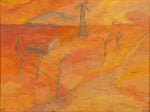Sol LeWitt e Ignacio Uriarte – Muro e Parete
.jpg)
Mostra di Sol LeWitt e Ignacio Uriarte.
Comunicato stampa
Diversamente dall’inglese, il latino, l’italiano e il tedesco (così come molte altre lingue) distinguono tra “muro” e “parete”. La distinzione sta nel fatto che con “muro” si intende la base fisica portante. In particolare negli interni, il muro viene rivestito con uno strato di intonaco, dando così vita a una superficie che finisce per far perdere di vista la sottostante presenza della struttura materiale e muraria. La parete liscia diventa una superficie di proiezione e immaginazione, su cui possiamo rappresentare qualsiasi cosa. È lo spazio figurativo che gli artisti dell’antica Roma utilizzavano per la decorazione delle ricche ville. Sulle pareti potevano raffigurare dei mondi che superavano la limitatezza degli interni, richiamando architetture esotiche o lussureggianti scene di paradisi naturali.
In questo senso, i Wall Drawings di Sol LeWitt sono ovviamente qualcosa in più di disegni di grandi dimensioni. La caratteristica di queste opere è da individuare nel loro stretto collegamento con lo spazio.
In "Wall Drawing 247" le linee da e verso punti casuali specificati sulla parete sono determinate dal disegnatore con pastelli neri. Qualsiasi differenza nell'installazione dipende dalle differenze tra le pareti su cui viene disegnato il pezzo. Il disegno si muove quindi in una sua propria dimensione, che va al di là dello spazio reale. La parete visibile diventa quindi solo una parte di questa realtà ulteriore.
Con l’arte di lavorare la carta, Ignacio Uriarte è in grado di trasformare la parete bianca in un rilievo di fogli di carta del medesimo colore.
L’arte ha il privilegio di non dover necessariamente produrre qualcosa, a volte è sufficiente ingrandire o portare in primo piano un gesto piccolo e occasionale per rivelarne il potenziale estetico. All'interno di ogni foglio di carta sono state praticate quattro pieghe che si congiungono in modo da comporre in modo casuale una figura a forma di rombo; ogni rombo si connette poi con le analoghe figure dei fogli adiacenti, al di sopra, al di sotto, a sinistra e a destra, tracciando in tal modo tra i fogli un'ulteriore serie di rombi uguali, che si delineano sullo sfondo rispetto al rilievo delle pieghe.
Le pieghe da un lato riflettono la luce e dall'altro creano un gioco di ombre. Si vengono così a determinare anche differenti gradazioni di bianco e di grigio pur in assenza di una reale tecnica di colorazione.
.Testo di Helmut Friedel
***
May 30 - September 8, 2017
Opening: May 26, 6:30 pm
Latin, Italian and German – and many other languages as well – have two words for ‘wall’, in contrast to English, which only has one. German, for example, differentiates between ‘Mauer’ and ‘Wand’: ‘Mauer’ is the physical, load-bearing base constructed of stone or brick or other materials. In interiors in particular it is usually covered with a layer of plaster, which provides a surface that neatly hides the physical structure of the ‘Mauer’ or wall beneath. This smooth surface or ‘Wand’ becomes a surface for the imagination, for projection, on which anything can be portrayed. It is the image surface that artists of ancient Rome sought in decorating wealthy villas. On this surface they could bring forth image worlds that point far beyond the limits of the room indoors – to foreign architecture or magnificent paradisical scenes.
In this light, the Wall Drawings by Sol LeWitt are of course much more than simply over-sized drawings. Their essential element is that they should be seen within their close frame of reference to the room. In "Wall Drawing 247" the lines to and from random points specified on the wall are determined by the draftsman with black crayons. Any differences in the installation are due to differences between walls on which the piece is being drawn. The drawing now moves in its own dimension, which extends beyond real space.
With his artful handling of paper, Ignacio Uriarte can transform the white wall into a relief of white sheets of paper. Art possesses the privilege of not having to be productive, and it is frequently enough to enlarge a small, casual gesture or place the focus on it in order to make its aesthetic potential accessible.
Each sheet of paper contains four folds that connect to a randomly shaped rhombus that connects further to the rhombus on the pages above, below, to the left and to the right, creating thereby a new, additional layer of rhombusses in between the pages that looks almost the same, but with depression instead of protrusions.
The folds reflect the light above them and throw shadows below them. Different gradings of white and grey are created this way without the actual use of color.
.Text by Helmut Friedel



